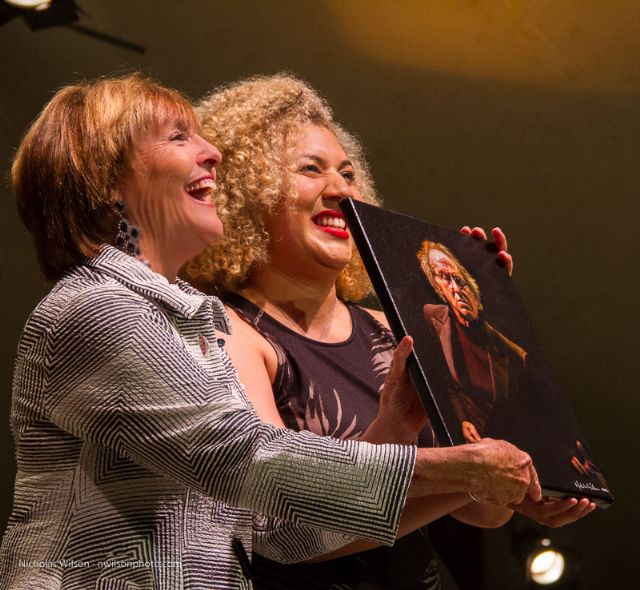|
Symphony
FROM THE NEW WORLD TO THE OLD WORLD
by Peter Lert
Saturday, June 14, 2025
Chamber
MC2 DUO RECITAL CLOSES 222'S SEASON
by Terry McNeill
Saturday, June 14, 2025
Choral and Vocal
CANTIAMO SONOMA'S LUSCIOUS A CAPELLA SINGING IN SEASON ENDING CONCERT
by Pamela Hicks Gailey
Sunday, June 8, 2025
Symphony
SRS SEASON ENDS WITH RESOUNDING TA-TA-TA-BANG
by Terry McNeill
Sunday, June 1, 2025
Symphony
YOUTHFUL VIRTUOSITY ON DISPLAY AT USO'S MAY CONCERTS
by Peter Lert
Saturday, May 17, 2025
Symphony
MYSTICAL PLANETS AND LIVELY GERSHWIN ORTIZ AT FINAL SRS CONCERT
by Peter Lert
Sunday, May 4, 2025
Symphony
VSO'S CONCERT MUSIC OF TIME, MUSIC OF PLACE
by Peter Lert
Sunday, April 27, 2025
VOCAL ELEGANCE AND FIRE AT THE 222'S RECITAL APRIL 26
by Pamela Hicks Gailey
Saturday, April 26, 2025
CANTIAMO SONOMA SINGS AN INSPIRED GOOD FRIDAY MOZART REQUIEM CONCERT
by Pamela Hicks Gailey
Friday, April 18, 2025
DRAMATIC SHOSTAKOVICH SYMPHONY CLOSES PHILHARMONIC'S 25TH SEASON
by Terry McNeill
Sunday, April 13, 2025
|
 |
 Frederick Von Stade (l) and Melissa Angula July 22 with Alan Pollack Photo (N. Wilson photo) |
MOZART'S GENIUS UPSTAGES DIVA, YOUTH AND CONDUCTOR IN STERLING MMF CONCERT
by Terry McNeill
Wednesday, July 22, 2015
Mendocino’s eclectic Music Festival gave a strong imprimatur to the Mozart theme July 22 with a radiant orchestral and vocal concert in the big white tent on the Mendocino headlands.
The Overture from “The Abduction from the Seraglio” (K. 384) opened the concert in an adroit reading that was a happy prelude to the anticipated singing and the famous final Mozart Symphony.
In the first half works associated with Mozart’s operas were heard, and the starring role was given to the splendid mezzo-soprano Fredericka Von Stade. The venerable artist sang two arias (“Vedrai Carino” from Don Giovanni and “Una donna a quindici anni” from Cosi Fan Tutte), charmed the audience with repartee as only a diva can do, and joined with two young singers from Berkeley in sparkling duets. Jeremiah Smith came first with the “La ci darem” from Don Giovanni, a baritone aria that he sang with refinement but without the requisite power, and Ms. Von Stade was his perfect foil as Zerlina. More vocal potency came from soprano Melissa Angula in “Come scoglio” (Cosi), the singing being energetic but top notes were shrill and the orchestra covered her at times. Ms. Angula commands and long and even trills.
How is Ms. Von Stade at this point in a career that began 45 years ago in New York? She still has a lyrical Cherubino (Marriage of Figaro) with deft communication and élan if slightly reduced projection and vocal color, and she ebulliently commanded every inch of the stage. In the duo with Ms. Angula they sang from a faux score that when turned over revealed and large Nicholas Wilson photo of Mr. Pollack, to much laughter and apparently was unforeseen by the conductor. Ovations during this set from the audience of 750 were long and loud.
As good as the singing was, the C Major Symphony (K. 551, “Jupiter”) was the concert’s highlight. Here conductor Alan Pollack brought mostly moderate tempos to the four movements of Mozart’s last and greatest symphonic work. Solid brass and flute (Mindy Rosenfeld) playing characterized the opening Allegro Vivace with several modulations bringing the composer’s dramatic contrasts into relief and a lovely oboe solo from Thomas Nugent.
The Andante had a personal character with pathos and an occasional rhythmic surprise. The muted strings sounded suitably rich. The Minuet was played in the manner of Haydn, richly blossoming into the Trio of winds and strings. The conductor controlled all very well, letting the tympani give just the right foundation support.
If the multi-fugue finale doesn’t excite an audience, no Mozart symphony movement will, and here Mr. Pollack drove a quiet beginning into a swifter tempo than anything before. The many short themes whirled by with a lot of energy, and the conductor never let the polyphony become murky, even with the tent’s unique acoustics and at elevated volumes.
It was an uplifting and cogent performance, down to the final six epochal chords that were in a small way an additional declaration of Mozart’s compositional genius.
|

